Introduction
Several years before we moved to Europe, I purchased a book called European Festivals*, written by our travel guru, Rick Steves. In this short book, Rick describes ten festivals beginning with Carnevale, which is celebrated all over Europe in the spring, and ending with the Christmas Markets at the end of the year.
The last chapter in the book is titled “Reader’s Favorites”. Rick asked his Facebook readers to submit their favorite festivals, and he selected 30 to add to his collection.
I had always been captivated by one on the list called Las Fallas, the Fallas Festival. This festival is celebrated every March in Valencia, Spain, to honor the coming of Spring and the feast of St. Joseph.
The Fallas Festival
Over five days in March there are huge displays of fireworks, parades with bands, street parties, and people dressed in traditional garb. One of the major highlights is the Ofrenda Fallas, a pilgrimage when 50,000 people offer flowers to the Virgen de los Desamparados, Our Lady of the Forsaken, the patroness of Valencia.
All across Valencia, handmade statues are erected in the streets. The statues, called ninots (“nee-notes”), are constructed by citizens and artists alike, and depict images of life in Valencia. Sometimes they are satirical and may contain subtle political messages. Others are realistic or nostalgic.
Since the mid-1930’s, a competition has been held to identify the best ninot. Visitors and citizens vote for their favorite, and the winner is “pardoned” and saved. Pardoned from what, you might ask? THE FIRE!
Traditionally, the statues are all set on fire on the 19th of March, the feast of Saint Joseph.
We were in Valencia in September, so we missed all the hoopla surrounding the festival. But we did make time to tour the Museu Faller de Valéncia, the Fallas Museum. It is an incredible place where you can admire all the pardoned ninots from the 1930’s until today.
Changing times, changing techniques
The ninots from the 1930’s and 40’s were made from wax, wood and cloth. They told the story of traditional Valencian life, depicting craftsmen and popular citizens.
By the 1950’s, social issues became a prominent topic of the ninots. After all, it was post-war period where there was a lack of basic goods. In 1956, a ninot made of papier-mâché was pardoned for the first time.
By the 60’s, satirical figures showed comical scenes related to the social changes in Valencian society. The 70’s depicted caricature-like figures with hardly any political content. In 1977, a ninot made entirely from polyester was pardoned for the first time.
The 80’s ninots showed society in a nostalgic way but still used caricature features to describe what was going on in society. The 90’s ninots showed emotional scenes that pictured ancestral family values. In the 90’s a new material, expanded polystyrene, was introduced.
A brief tour of the museum
Here are some of our favorite ninots.
1941
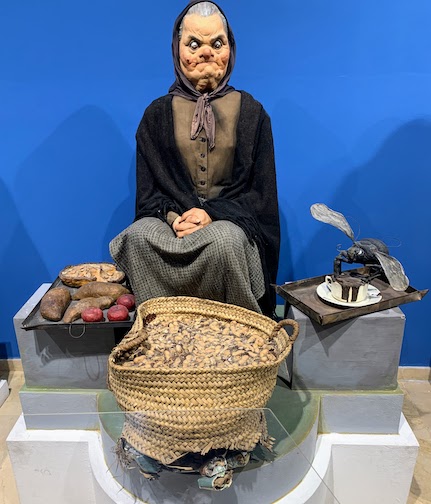
“Black Market Peanut Seller”
This ninot reflected hard economic times under the Franco regime after the Spanish Civil War. The old lady is selling peanuts and sweet potatoes, but also black market tobacco out of the bottom of her basket to earn enough money to live on.
1956

“Family of Indian Tourists”
These figures allude to the influx of scantily clad American visitors who came to military bases in Spain. Many Valencians found these newcomers to be outlandish.
1958
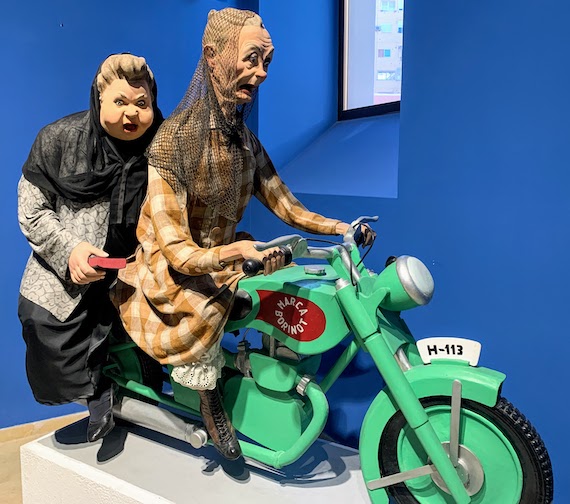
“Vespa for taking grandmothers to mass”
This ninot illustrated one aspect of the cultural changes taking place in the late 1950’s. Traditional values (the grandmothers) were being challenged by modern inventions (the motorcycle).
1961
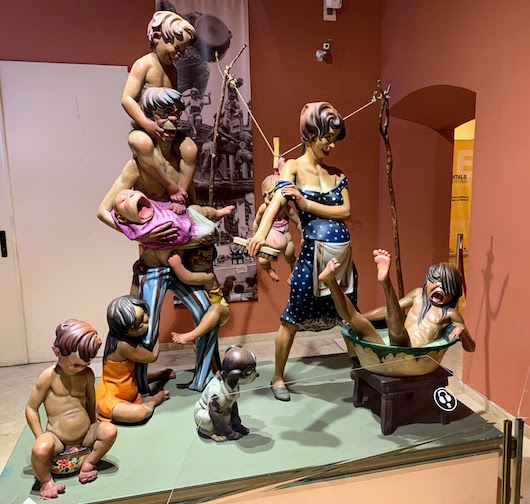
“The punishment of being too many”
The “Baby Boom” of the 1950’s and 60’s was depicted in this ninot that shows a growing, chaotic family in tough economic straits. Their situation was aggravated by a lack of birth control – note that the woman is pregnant…again!
1971
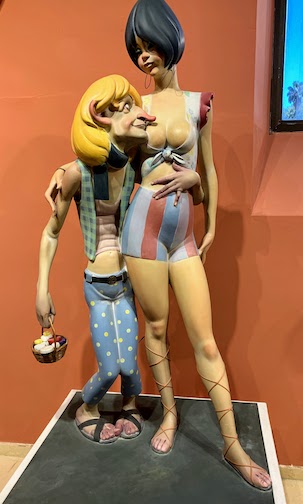
“Couple of Hippies”
This ninot shows a caricature of young people in the 1970’s, heading for a picnic at the beach with a basket full of birth control. (We went to college with these folks!)
1976
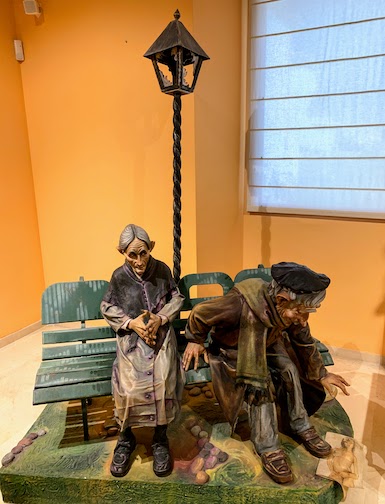
“Awakening eroticism”
This was the first ninot pardoned after the death of the dictator Franco. It shows an old man reaching to pick up an erotic magazine, reflecting changing attitudes toward sex and morality as Franco-era restrictions dissolved.
1980
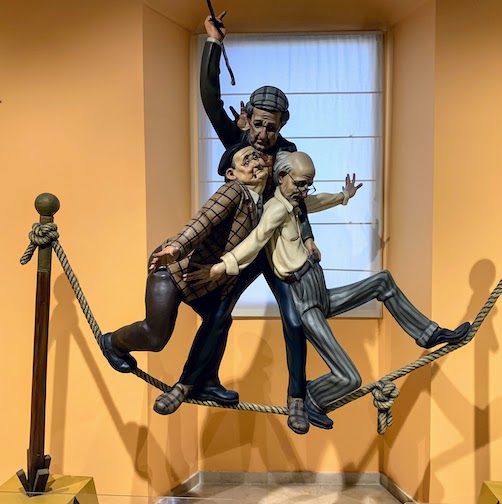
“The tightrope”
The precarious financial balancing act performed by older Valencians – living on meager pensions and facing rising costs and taxes – was illustrated in this ninot.
1984
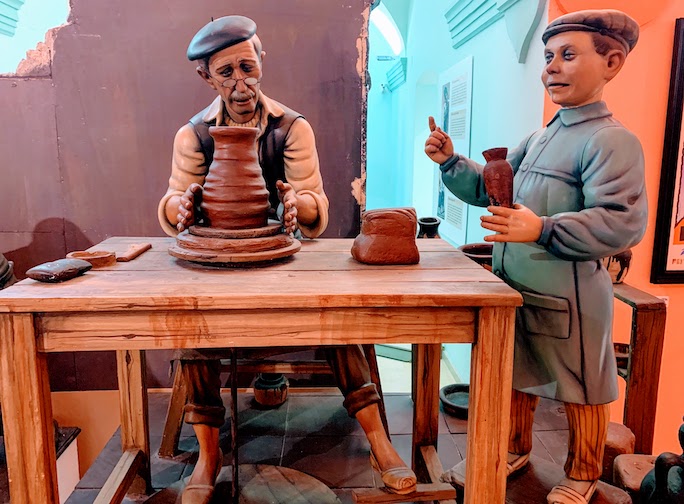
“The potter and the apprentice”
In the face of increasing industrialization, this ninot highlighted the continuity of traditional crafts being passed to new generations.
1995

“With the police on the heels”
With a nod towards the chase scenes in silent films and the “Police Academy” films, this ninot reflected a controversy about the effectiveness of neighborhood police in Valencia.
1999
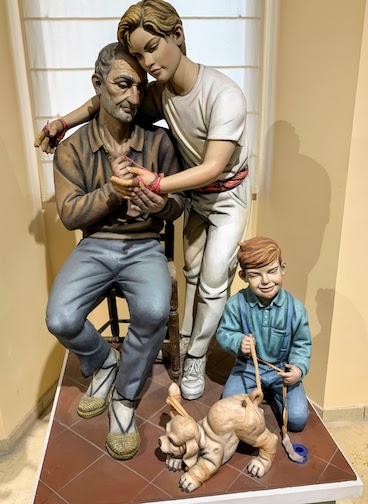
“The Valencian ball”
Many ninots in 1999 illustrated domestic scenes. This one depicts a man helping his grandson prepare to play pilota, a popular Valencian handball game.
2010

“Enough with the little machine, we’re late…
The impact of new technology on traditional customs is shown in this ninot. The boy playing the game is neglecting his responsibility to escort the queen of the Fallas to the opening ceremony.
2015

“Grandma’s cuisine”
Corruption in Spanish society, including cuisine, was satirized in this ninot. Grandma is pouring a can of bean stew into a pot and intends to pass it off as her own creation, and enlisting her grandson in the subterfuge.
Such incredible craftsmanship
We were fascinated by the level of detail and craftsmanship in each of the ninots on display, and could only imagine what interesting creations had been burned. In addition to the near life-size ninots shown above, there was also a display of smaller figures, like the one below.

The 2023 Fallas Festival will take place from 15 to 19 March next year. There are hotel rooms available (as of mid-October, 2022). so if you’re looking for a spring trip with a mix of art, culture, and fireworks, this could be a great option for you.
To whet your appetite even more, here’s a 2 minute video preview.
What cool festival have you been to this year? Tell us about it with a comment below or a note via the Contact Us form. We might want to add it to our travel plans for next year.
Until next week / Até a próxima semana
Mary
The Cook
* This link is direct to Amazon.com. At the time of this writing (October, 2022), we receive no affiliate payment if you buy a copy. If that changes in the future, we’ll let you know.
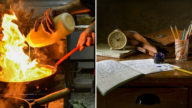

Thanks for sharing! What a great museum, and to see the traditional ninots, with explanation, is a very interesting way to learn a little about the culture. We visited this festival last year before we came to Portugal. Although to say we visited is a bit misleading. You can’t avoid it! They place the ninots in the middle of intersections, so traffic is diverted around them. The main part starts the week before the burnings and things are happening every day. Firecrackers in the streets ALL the time, la Mescletá (LOUD, booming explosions for 5 minutes) each day at 2 pm (from Wednesday on), bands wandering the streets along with parading Spaniards in traditional costume. And then there are the fires. It is an experience like none other. They also have these festivals in other parts of the Valencia Community, in Dénia, and Gandía. The one in Alicante is in June, to coincide with the night of St John. We should be there, then. Please come visit us!
I saw where your visas have come through. I know you are excited for your move. Thanks for all your notes about the festival. I had not remembered until now, but it was you who had first told me about the Ninots (over lunch in Cascais). We got word from some other friends that they would like to go to Valencia in 2023 to take in the festival. We are going to try to go with them. Thanks for the invitation to Alicante. We’ll have to share lunch agian.
Your trip sounded most Interesting and something I have never experienced or even heard of during my travels. “Life is a Festival” Eddie and I have attended the Festival of Arts in Laguna Beach , CA almost every summer and always enjoy the Art and music. Some very unusual but always interesting. Keep on traveling and discovering new things!! Love, Sue & Eddie
You and Eddie are always up to something. I’m glad you get to enjoy the festivals in CA. We will be back in the US for little Guy’s first Christmas. Will and Julia do Zoom calls almost every week. Technology makes being away so much easier. Love to you and Eddie.